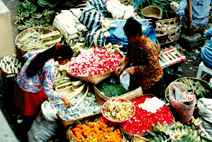Special Feature: Products Sally Recommends
Regions of Bali
Kupu Kupu Barong, Ubud
 This
must be one of the most idyllic panoramas in this world. We're sitting on the
veranda of one of the traditional Balinese style buildings grouped along the top
of the precariously steep slope leading down the lush green valley to the rock-strewn
river below. Echoes of the turbulent, crystal-clear water drift up the steep valley,
with sounds like a distant, muted waterfall.
This
must be one of the most idyllic panoramas in this world. We're sitting on the
veranda of one of the traditional Balinese style buildings grouped along the top
of the precariously steep slope leading down the lush green valley to the rock-strewn
river below. Echoes of the turbulent, crystal-clear water drift up the steep valley,
with sounds like a distant, muted waterfall.
Until an hour ago, inflatable rafts with plastic-helmeted, paddle-wielding tourists have been bobbing and bouncing down these rapids. But now they are gone and our attention is drawn to a handful of villagers on the opposite bank of the river. They have finished their day's work in the coconut plantation covering the opposite side of the verdant ravine, and now, like tiny toy figures, they bathe, wash clothes and play. Some of the women are wearing only sarongs, the fact that their bodies are bare to the waist looking perfectly natural. Small children, naked bodies soaking up the last warmth of the afternoon sun, frolic in the shallows, their laughter soft and and distant.
 From
our vantage point there is much more to see. Emerald rice paddies -- engineering
masterpieces -- are like a giant staircase for climbing up the valley. Each is
sloped in such a way that water running in at the top flows down into each of
the various, carefully dammed fields and then gently overflows into the paddy
below it.
From
our vantage point there is much more to see. Emerald rice paddies -- engineering
masterpieces -- are like a giant staircase for climbing up the valley. Each is
sloped in such a way that water running in at the top flows down into each of
the various, carefully dammed fields and then gently overflows into the paddy
below it.
The air is warm and heavy with the natural perfume of vivid red, white and yellow flowers. These are visited by a mysterious variety of large jet-black bees that are almost the size of tiny hummingbirds that we have seen in South America. On the other side of the resort, villagers have started to practice their gamelan music. Its faint strains now add their tantalizing sounds to those of twittering birds, the distant laughter of the children, and the murmuring river below.
We are staying at Kupu Kupu Barong at Ubud in Bali's high country, the area where exquisite paintings, wood carvings, silverwork and other arts and crafts have been traditionally produced for centuries, and it would be hard to find a more idyllic setting for a holiday. No wonder artists, poets and writers have been inspired by Bali for over a century.
Nusa
Dua
 Luciano
Pavarotti can afford to holiday in any place he likes. And now this world famous
tenor, surrounded by friends, is relaxing in the loungeroom of one of the two
private villas of the impressive Hyatt resort at Nusa Dua. Enchanted, he watches
a troupe of traditional Balinese dancers with intricately designed, crown-like
headdresses and splendid gold embroidered and brightly colored costumes. Slowly,
they go through the precise movements of the Hindu inspired sequences, accompanied
by the bell-like notes of their gamelan musicians. This hotel, with its combination
of Balinese culture and western comfort, will make your visit to Bali an exercise
in "La Dolce Vita."
Luciano
Pavarotti can afford to holiday in any place he likes. And now this world famous
tenor, surrounded by friends, is relaxing in the loungeroom of one of the two
private villas of the impressive Hyatt resort at Nusa Dua. Enchanted, he watches
a troupe of traditional Balinese dancers with intricately designed, crown-like
headdresses and splendid gold embroidered and brightly colored costumes. Slowly,
they go through the precise movements of the Hindu inspired sequences, accompanied
by the bell-like notes of their gamelan musicians. This hotel, with its combination
of Balinese culture and western comfort, will make your visit to Bali an exercise
in "La Dolce Vita."
Kuta Beach
 A
group of young men and women in their 20's and 30's chatter their way beachwards
from their modest hotel along the Kuta tourist strip. Only a few years ago this
was a dismal area of dilapidated stalls selling cheap tourist junk. The smell
was then awful, a combination of open sewers and rotting refuse. Today the stalls
are still there. But the open drains have become proper underground sewerage lines.
A
group of young men and women in their 20's and 30's chatter their way beachwards
from their modest hotel along the Kuta tourist strip. Only a few years ago this
was a dismal area of dilapidated stalls selling cheap tourist junk. The smell
was then awful, a combination of open sewers and rotting refuse. Today the stalls
are still there. But the open drains have become proper underground sewerage lines.
The hawkers' booths lining the main road and side streets that lead to the beach have been rebuilt and cleaned up. Roadside food stalls that, just a few years ago, would have given visitors a debilitating dose of Bali Belly now have to comply with sanitation requirements that at least give the tourist a good chance of not being struck down. And the beach itself, previously an unkempt stretch of polluted, litter laden sand, now sports a well made bitumen access road with flowering garden borders.
Kesiman Village
 Kesiman
village is one of many places where tourists come to see the more intricate, beautifully-costumed
dances that are Bali's way of passing the stories of Hindu religion and Balinese
culture from one generation to the next. Tourist buses are flowing into the carpark
in a well-orchestrated bus-ballet. The visitors that pile out are from Japan and
Korea, Malaysia and Singapore, Australia and New Zealand, Holland and Germany,
France and the U.S.A. Soon everyone is seated and the Barong dance, which depicts
the struggle between good and evil, begins. The story is about the Barong, a mythical
lion-like animal which is the essence of goodness, pitted against the evil widow-witch
Rangda.
Kesiman
village is one of many places where tourists come to see the more intricate, beautifully-costumed
dances that are Bali's way of passing the stories of Hindu religion and Balinese
culture from one generation to the next. Tourist buses are flowing into the carpark
in a well-orchestrated bus-ballet. The visitors that pile out are from Japan and
Korea, Malaysia and Singapore, Australia and New Zealand, Holland and Germany,
France and the U.S.A. Soon everyone is seated and the Barong dance, which depicts
the struggle between good and evil, begins. The story is about the Barong, a mythical
lion-like animal which is the essence of goodness, pitted against the evil widow-witch
Rangda.
This long and fascinating dance involving demons, goats, and all sorts of other characters from Hindu scriptures, is made even more interesting by its setting in an authentic Balinese temple. And the dancers are the same villagers that perform these same dances as part of the Balinese religious ethic.
For centuries, these dances have been performed here, but these days the whole setup seems blatantly touristic for most of the year, except at the Galungan Festival when locals attend in large numbers because the dance is an entertainment for the gods and ancestral spirits. Will tourism at all these facets of Bali eventually over commercialize, and then ruin the cultural fabric of the island?
In many countries where foreign tourists arrive in large numbers, the subtle changes they create in the local population is often the cross-cultural rot that sets in and wipes out authentic, ancient culture. One only has to visit Thailand's Pattaya or go to Nepal to see to what extent local cultures can be prostituted into a sad parody of themselves once locals start to chase the mighty dollar and pattern themselves on the wants and lifestyles of the visitors rather than on their own.
But how would the Balinese tackle this problem? We got a real insight into what had been done and was planned for the future by talking to Australian Alistair McCracken, the Resident Manager at the sumptuous Hyatt Regency in Bali's new resort area of Nusa Dua. His explanation was as fascinating as it was informative. "In the pre-war days of Dutch rule, when tourists had to come here by ship, some of the world's great painters, poets and writers discovered Bali. Tourism was almost non-existent then and there were no more than around 800 foreign visitors on Bali at any one time. Yet even in the 1920's some of the foreigners who had taken up residence here thought this was too much and lamented that the tourists would ruin the island's culture. In reality it wasn't that great a problem because the high cost in time and money necessary to reach Bali certainly kept the masses away."
McCracken went on to say that all of this changed in 1970 when the first jumbo-jets took to the air. Even before that it was becoming obvious that tourism, while bringing in substantial income as a benefit, also had its negative side by eroding Balinese values. "The destruction of Balinese culture began in a relatively small way in Kuta. Bali's beach area was the prime destination for the young, and often penniless Australian, American and New Zealand drop-outs. They found Kuta an ideal low-cost base at which to live cheaply while pursuing surf, sun, sex and, too often, drugs. This, in turn, attracted many young Balinese in their 20's. If the foreigners could live like this, why couldn't they?
Many of the youngsters drifted to Kuta, breaking away from their family ties and their Balinese ways to pattern their lifestyle on those of the visitors and also live as beachbums. In the early '60's the Indonesian Government realized that it would not be long before one airplane could carry as many people as a medium-sized luxury liner and reach Bali from anywhere in the world in less than two days. Hence, tourism would explode and put Balinese traditions and culture at risk.
There would have to be a plan to neutralize the potential crisis that would be created by mass tourism. And not only did the Balinese set up an enquiry, form committees, get international help and address the problem, but the result is one of the great success stories of international tourism.
First the investigators wanted to identify the problems found in other countries, so that they could devise their plan to avoid them. So they went to places like Thailand's Pattaya, Mexico's tourist strip along the beach of Acapulco, and Spain's Costa del Sol concrete jungle in Torremolinos. They found that as rural areas grew in tourist popularity, get-rich-quick developers sprang up like mushrooms, building far too many shops, stores, lodging houses and ugly glass-and-concrete highrises. The areas lost their style and beauty, becoming dangerously polluted and unattractive.
Villagers, seduced by the easy tourist dollar, had given up their homes and moved to the tourist strips. Invariably, the reputation of these places suffered, with a dramatic downgrading of tourism and per capita spending. All this had to be avoided in Bali, so in the '60s, a survey was taken to identify sites which, due to very localized circumstances, were sparsely inhabited. The surveys found a number of such areas, not only with a very low population density, but also with a rainfall that was way, way below average. In the case of Nusa Dua the ground was so full of limestone that, combined with the low rainfall, the area would not even support subsistence farming in bad seasons. If this land area and others unsuitable for farming, could be recycled into tourist areas, they would not only provide employment for the few people that lived there, but for others who could commute from towns like Denpasar. It seemed a perfect concept. Reports from experts indicated that there would be other benefits, too. By building self-contained luxury resorts in low rainfall areas, the good weather image in what is basically a tropical/monsoonal part of the world would be maximized. By putting the resorts on the poorest possible land which, therefore, was vacant, almost no Balinese would have to be relocated.
"The plan was brilliant in every way." says McCracken. "The tourists could come, stay in absolute luxury, bus out to villages to observe -- but not disturb -- Balinese life and customs, and then fly home laden with souvenirs. As these are mainly traditional handicrafts like woodcarvings, paintings, textiles and silversmithing, it would encourage ancient arts and crafts to again flourish."
No time was wasted. By 1971 the master plan for Nusa Dua was completed. Marshland would be drained, water would be piped down from the mountains, roads, golf courses and other tourist infrastructure would be created, the whole area would be built to a controlled master plan, many resorts being Indonesian-owned but managed by the best international tourism operators.
Architects were commissioned to create resorts that would be truly Indonesian in style and flavor, yet so international and modern in facilities and comforts that guests would feel pampered and contented, regardless whether they had arrived from Los Angeles, Tokyo, London, Moscow, Seoul, Sydney or Hong Kong. It worked!
The Grand Hyatt resort at Nusa Dua is a classic example of the result of this plan. Like the rest of the new super-resorts, buildings are low-rise. The Hyatt is set in 40 acres of lush gardens interspersed with buildings architecturally reminiscent of Balinese villages. These are connected by garden walks, pools and cascading waterfalls.
 Each
room or suite looks down into its own tropical garden and pool area. Looking at
the lush, tropical vegetation, it would be hard to guess that all the topsoil
was trucked-in during construction and that the life-giving water is piped across
from distant mountain slopes that have many times Nusa Dua's rainfall.
Each
room or suite looks down into its own tropical garden and pool area. Looking at
the lush, tropical vegetation, it would be hard to guess that all the topsoil
was trucked-in during construction and that the life-giving water is piped across
from distant mountain slopes that have many times Nusa Dua's rainfall.
 In
addition to the standard luxury suites, there are two supersuites in the form
of superb Balinese-style villas surrounding by their own walled courtyard gardens.
These villas come with their own private butlers, swimming pools and a spacious
luxury for which VIP's and Heads of State travel halfway across the world. Day
trips allow hotel guests to see, but not interfere with, the culture, temples,
lifestyle and religious-based dances of the island, while each night local village
dancers perform poolside.
In
addition to the standard luxury suites, there are two supersuites in the form
of superb Balinese-style villas surrounding by their own walled courtyard gardens.
These villas come with their own private butlers, swimming pools and a spacious
luxury for which VIP's and Heads of State travel halfway across the world. Day
trips allow hotel guests to see, but not interfere with, the culture, temples,
lifestyle and religious-based dances of the island, while each night local village
dancers perform poolside.
This, and the fact that a large number of shops as well as a nightly handicrafts market inside the 'main street' of the resort sell some of the finest products the artists and artisans of Bali can create, makes for a situation where many visitors don't even bother to leave the hotel grounds during their stay.
"In effect," says McCracken, "the Government has insulated but not isolated the foreign visitors. They cannot close down the many small guest houses already in existence in places like Kuta and Ubud, but they do not allow new ones to be established. The expansion of tourism will go into the pre-planned areas, and it's fantastic that this is so."
Nusa Dua already has such superb resorts as the Sheraton Nusa Indah, Putri Bali, Nusa Dua Beach Hotel, Melia Bali Sol Hotel, and Sheraton Lagoon Resort. Jimbaran Bay is home to the superb Four Seasons and Intercontinental resorts. Other designated tourist areas with hotels of great style are in Ubud, Seminyak, Tuban, Legian, Sanur, and with Ungasan in the pipeline.
In places like Ubud, located in the highlands and surrounded by artist villages, it is a combination of putting new resorts into locations that are unsuitable for agriculture and providing accommodation that, while extremely comfortable, somewhat segregates the tourists from the daily village life so that locals can get on with their routine without interference.
The program ensures that in spite of a substantial increase in visitor numbers, Balinese culture and village life will remain intact. So put Bali on your "must go" list. We are sure you won't be sorry.
Introduction | Basic Facts | Supplemental Information
Note: This information was accurate when it was published. Please be sure to confirm all rates and details directly with the businesses in question before making your plans.



